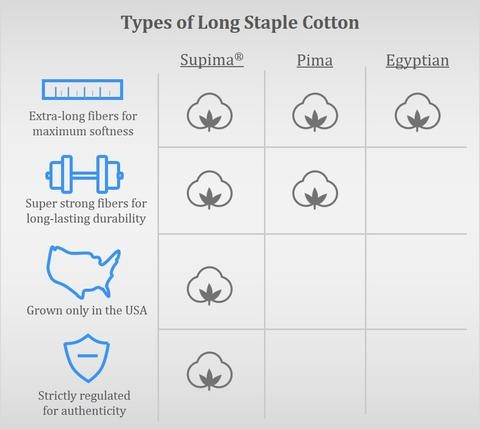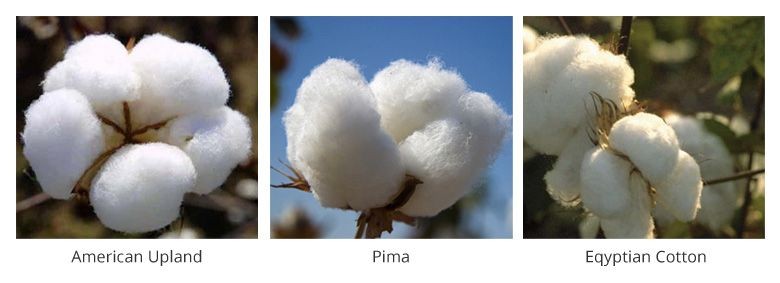Pima Cotton vs Egyptian Cotton, Which is Softest?

There are five main varieties of cotton that are commercially grown. For comparison, just in the United States, there are about 2,500 varieties of apples. Cotton fibers may be similar, but each variety has its own properties. Egyptian material is very soft, while Asiatic material is coarse, used for blankets and other types of cloth. The most common type is Upland, which is used for a variety of products, even seed oil. Although the bolls of Upland material may be good for general use, the best cottons for fabrics are varieties that produce an extra-long staple. Here’s a primer on the difference between the two varieties.
What is Pima Cotton?
Pima cotton originated in Peru, but it is really an American marvel. Originally, it was grown in South Carolina. Producers cross-pollinated cottons to obtain an extra-long staple material. It was the Arizona Pima tribe that worked with the Department of Agriculture to bring innovations to the crop and make it the superior material that it is today. In the mid-20th century, there were many advances in quality to make it a premier variety today. It is mostly grown in Texas, California, Arizona, and New Mexico.
This variety is an extra-long fiber that measures 1.4 to 2-inches in length. Most fibers are around one inch long or less. It needs to be harvested by hand to protect the fibers. Pima produces a smoother fabric that is durable and soft. Careful harvesting maintains the true color of the material, so it takes to dyes very well. It makes one of the most luxurious fabrics in the world, but there are many fakes. The material can be scientifically verified and labeled to ensure the quality difference. It is hypoallergenic, too. It’s a great fabric for people with sensitive skin.
What is Egyptian Cotton?
Egyptian material is considered one of the finest fibers in the world. At one time, the name referred to where it was grown. Today, the material is still grown in Egypt, but it is also grown in Peru, India and the United States. One of the key differences with this material is that it is hand-picked. This puts less stress on the fibers. The fibers can be produced into very fine yarns that are softer than regular material because the fibers remain straight after picking. It is a very flexible and durable fabric that makes luxurious bed sheets.
One thing to note is that this is a variety that can be grown anywhere it’s hot and dry. Some manufacturers label any type grown in Egypt as Egyptian, even though it may not be as soft and durable as true extra-long-staple. You can’t just look at the country in which the material was grown to get authentic material designed for quality. You have to look carefully at the type of material that was woven into the fibers.

How are These Different?
Both types share many similarities that make for a luxurious fabric. The main difference between the two is that the former is grown primarily in the United States, while Egyptian is grown in a hot, dry climate like the Nile River Valley. Both varieties are known as “extra-long staple cottons,” that produce a high-quality fabric. Either will make a wonderful set of sheets, provided that the material is correctly labeled. As with other options, there are many fake types of Egyptian material, largely due to the fact that any material grown in Egypt can technically be labeled as “Egyptian material.”
Which is Softer?
Pima sheets are often considered the most luxurious in the world, provided that the label is 100% authentic. Because it is not necessarily superior quality, you may want to steer clear of sheets labeled as Egyptian unless it too has a scientific verification label. Pima sheets, even with lower thread counts, such as 200 to 300 are very soft and will last a long time because the fibers are longer and more durable.

Pima Cotton Is Eco-Friendly and Widely Sought After
Pima is usually sought after for bedding materials, but more fashion designers are using it in clothing because it is soft, durable and flexible. The former material drapes well and lends itself to a multitude of uses in the fashion industry. It’s also lightweight, yet still warm and it takes color well.
Organic material limits its environmental impact by being grown without fertilizers or pesticides. The crop is extremely sustainable when it’s consciously grown to reduce its impact on the environment.
If you’re looking for replacement parts for your harvester, contact Certi-Pik, USA for a large selection of specialty items and fabricated parts designed to get you back in the field instead of waiting for repairs.
